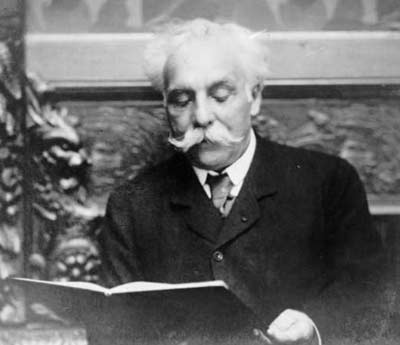Fauré, Gabriel (1845–1924)

Gabriel Fauré was Camille Saint-Saëns' favorite pupil at the Ecole Niedermeyer in Paris. Like his teacher, he was a gifted pianist and organist, and began his career as an organist in Rennes. In 1871 he became organist at Ste Sulpice in Paris, and was also active in the foundation of the Société Nationale de Musique, where many of his own works were given their premieres.
Fauré's engagement to Marianne Viardot (the daughter of a famous singer) produced three fine chamber works: the First Violin Sonata, the First Piano Quartet, and the Ballade for piano. In 1882, five years after Marianne broke off the engagement, he married Marie Fremiet, the daughter of a sculptor. The marriage, which produced two sons, was unhappy, and Fauré found consolation with other women, including Emma Bardac (the second Mme Debussy), for whom he wrote the tender song-cycle La bonne chanson, and for whose daughter Hélène (nicknamed Dolly) he wrote the Dolly Suite for piano duet.
Fauré continued to earn a living as organist, choir-master, and teacher, and was able to compose only in his spare time. He was happiest with small-scale genres such as songs, piano, and chamber music: many of his delicate, elusive songs are settings of texts by the Symbolist poet Paul Verlaine. His famous Requiem – probably his best-known work – took over 20 years to finish. In the late 1890s he was appointed principal organist of the Madeleine church in Paris, and also became a professor of composition at the Paris Conservatoire, where his pupils included Ravel. He became director of the Conservatoire in 1905.
By the age of 50 Fauré was well-known in Parisian society (his friends included Marcel Proust). By this time he was attempting larger-scale works, including the incidental music to Maeterlinck's play Midas et Maisande (which also inspired Debussy and Sibelius), the orchestral suite in 18th-century style Masques et bergamasques (1919), and the stage works Prométhée and Pénélope.
He retired from the Conservatoire in 1920, and was finally able to devote himself to composition, although by this time he was losing his hearing. His late works were mostly for chamber combinations, including a Piano Trio and Piano Quintet.


